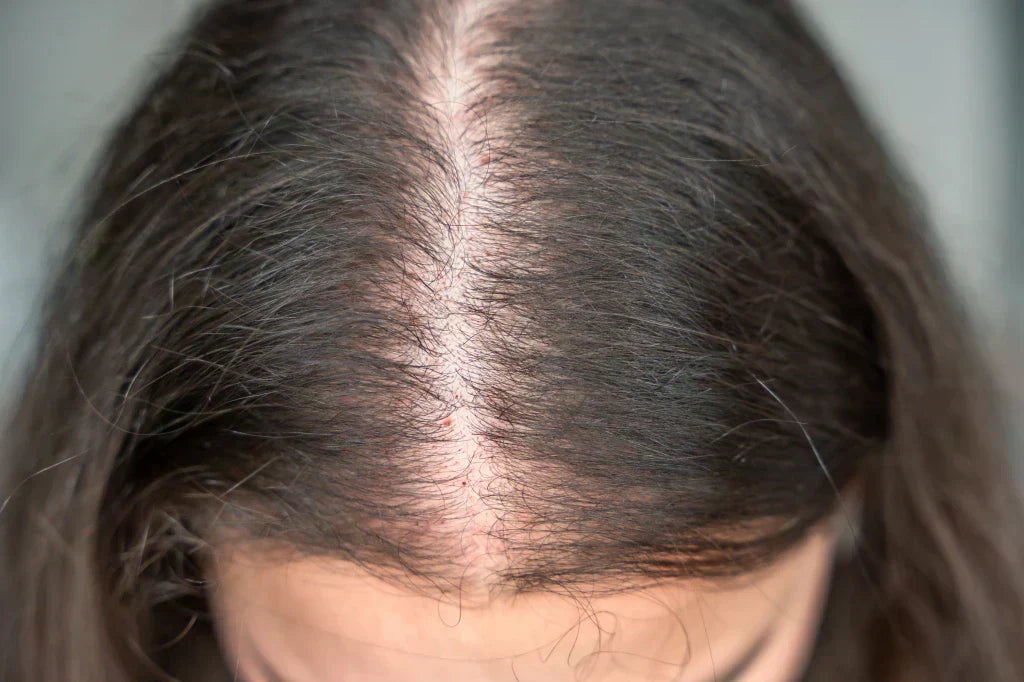
Hair Thinning: Causes, Types, and Treatment

Dr. Shireen Singh, MBBS.
Written by Our Editorial Team
Table of Contents
Do you know that approximately 85% of men and 33% of women experience hair loss? This can significantly affect self-esteem and appearance. Hair thinning, often an early sign of hair loss, can be caused by several factors, including genetics (pattern baldness), hormonal changes (pregnancy or menopause), stress, poor nutrition, medical conditions (like thyroid issues), and certain medications.
Unlike complete hair loss, thinning means hair is still present but reduced in density. The process usually starts slowly, particularly around the crown or temples, and becomes more noticeable over time. Early detection and intervention can greatly help slow or even reverse the process.
In this blog, we’ll take a deeper look into what causes hair thinning, the different patterns of hair loss, and the treatments that can help slow or reverse the process. Whether you're seeking to understand why this is happening or looking for solutions to address it, this guide will provide insights into how you can regain control over your hair health and restore both your hair and confidence.
How Does Hair Thinning Differ from Hair Loss?
What is Hair Thinning?
Hair thinning is a condition where your hair gradually becomes finer and less dense, making it look less full and voluminous. Unlike hair loss, which typically results in noticeable areas with no hair, hair thinning happens slowly over time. The individual strands of hair become thinner and weaker, so while your hair isn’t falling out in clumps, it may appear thinner overall. This condition can affect anyone but is most common as people age. However, other factors such as stress, poor nutrition, hormonal changes, or genetics can also contribute to hair thinning.
What is Hair Loss?
Hair loss is a condition where hair falls out more quickly than it can regrow, leading to noticeable thinning or bald patches. It can affect both men and women and may occur gradually or suddenly. Some people experience temporary hair loss, while for others, it can become a permanent issue. Common types of hair loss include male-pattern baldness and female-pattern hair loss. Understanding the cause of hair loss is important, as it can help in finding the right treatment or management approach.
The Gradual Nature of Thinning Hair and Its Early Signs
Hair Thinning is a slow and progressive process where hair becomes finer and the density decreases. The thinning hair may still be present, but it’s much less voluminous, and the scalp may become more visible. The affected areas typically include the crown, temples, or the entire scalp, but thinning can occur more diffusely across the head.
One of the defining characteristics of hair thinning is its gradual onset. The process can span months or even years, making it easy to miss in the early stages. Here’s a more detailed look at the progression of thinning hair and its early signs:
1. Increased Hair Shedding
A noticeable increase in the number of hair strands on your pillow, in the shower, or on your hairbrush may be one of the first signs of hair thinning. While shedding 50-100 strands daily is normal, an uptick in the amount can be a red flag that hair density is decreasing.
2. Wider Part
As hair thins, the scalp may become more visible, especially at the part line. For women, this can be particularly noticeable when parting the hair in the same place regularly. The part may appear wider, and the hair may appear more sparse near the roots.
3. Finer and Weaker Strands
As hair thins, individual strands become progressively finer, softer, and less resilient. Hair that was once thick and strong may feel limp and fragile. This makes the hair appear less voluminous, even though the number of strands may not be drastically reduced. Over time, you may also notice that your hair no longer holds its shape or style as effectively as before.
4. Visible Scalp
In more advanced stages of hair thinning, the scalp may become more visible, particularly in areas where hair naturally grows thinner, such as the crown or the hairline. This can create the appearance of a receding hairline or bald spots, although the hair is not fully gone. Instead, it’s simply thinner and sparser in those regions.
5. Thinning at the Temples and Crown
These areas are particularly prone to thinning in both men and women. For men, hair often thins at the temples and crown, while women tend to experience diffuse thinning across the scalp. Over time, these areas may expand as thinning becomes more pronounced.
6. Slower Hair Growth
As hair follicles become weaker, the rate of hair growth may slow down. You might notice that your hair takes longer to grow back after a haircut or seems to stagnate at a certain length.
Causes of Hair Thinning
Hair thinning can be caused by a variety of factors, from genetic predisposition to environmental influences. Understanding the underlying reasons for thinning hair is essential for addressing the issue effectively. Below are the main causes of hair thinning:
1. Genetic Factors
• Male and Female Pattern Baldness (Androgenetic Alopecia)
One of the most common causes of hair thinning is androgenetic alopecia, a hereditary condition that leads to a gradual thinning of hair. In men, it often manifests as a receding hairline or bald spots on the crown, while women typically experience diffuse thinning across the scalp. This condition is influenced by genetics and hormones, specifically dihydrotestosterone (DHT), a derivative of testosterone.
• Role of Family History in Hair Thinning
Genetics plays a significant role in hair thinning. If you have close family members (such as parents or grandparents) who have experienced hair thinning or pattern baldness, you’re more likely to experience the same. This hereditary link suggests that the gene responsible for hair loss may be inherited from either side of the family, although men are generally more likely to develop noticeable hair loss earlier than women.
2. Hormonal Changes
• Thyroid Disorders
An underactive or overactive thyroid (hypothyroidism or hyperthyroidism) can lead to hair thinning or hair loss. Thyroid hormones are crucial for regulating the growth and health of hair follicles, and imbalances can disrupt the natural hair growth cycle, causing shedding or thinning.
• Pregnancy and Postpartum Hair Thinning
Pregnancy causes hormonal changes that can initially improve hair thickness due to increased estrogen levels. However, after childbirth, estrogen levels drop, and many women experience postpartum hair thinning. This condition, known as telogen effluvium, occurs because the hair follicles enter a resting phase, resulting in excessive shedding that can last for several months.
• Menopause-related Hair Thinning
During menopause, a significant drop in estrogen and progesterone levels can contribute to hair thinning in women. As these hormones decrease, the body may produce more androgens (male hormones), which can lead to the miniaturization of hair follicles, making hair strands finer and less dense.
3. Nutritional Deficiencies
• Lack of Iron, Biotin, Zinc, and Protein
A poor diet or inadequate nutrient intake can affect hair health. Iron deficiency, for example, is one of the leading causes of hair thinning in women. Biotin and zinc are essential for healthy hair growth, and their deficiency can result in brittle, thinning hair. Protein, being the building block of hair, is critical for maintaining hair strength and growth. A diet lacking in these key nutrients can lead to weak, thinning hair.
• The Role of Poor Diet in Hair Health
A well-balanced diet that includes essential vitamins, minerals, and proteins is crucial for maintaining healthy hair. A diet high in processed foods or lacking in fruits, vegetables, and healthy fats can disrupt the body's ability to nourish hair follicles properly, leading to thinning hair over time.
Also Read: Essential Nutrients, Minerals & Vitamins for Hair Growth
4. Stress and Lifestyle Factors
• Telogen Effluvium (Stress-induced Hair Shedding)
Telogen effluvium is a form of temporary hair thinning that occurs due to stress or traumatic events. Stress can push more hair follicles into the resting phase (telogen phase) of the hair growth cycle, leading to significant shedding after a few months. This type of hair loss is usually temporary, but chronic stress can exacerbate the condition and prolong the thinning process.
• Overuse of Heat Styling and Harsh Hair Treatments
Excessive use of heat-styling tools, like flat irons, curling irons, and blow dryers, can damage hair follicles and lead to thinning. Similarly, harsh chemical treatments, including perms, relaxers, and frequent coloring, can weaken the hair shaft, making it prone to breakage. Over time, these factors can contribute to thinning hair, especially if proper hair care isn’t followed.
5. Medical Conditions and Medications
• Autoimmune Diseases like Alopecia Areata
Alopecia areata is an autoimmune disorder where the body's immune system mistakenly attacks hair follicles, causing sudden hair loss in small, round patches. This condition can affect individuals of any age and may result in severe thinning if not treated. It is thought to have a genetic component and can sometimes be triggered by stress or illness.
• Side Effects of Medications
Certain medications can cause hair thinning as a side effect. Chemotherapy drugs are notorious for causing complete hair loss, as they target rapidly dividing cells, including hair follicles. Other medications, such as those used to treat high blood pressure, depression, and acne, may also contribute to hair thinning. If you notice thinning hair after starting a new medication, it’s important to consult with your healthcare provider to see if the medication could be the cause.
Types of Hair Thinning
1. Androgenetic Alopecia (Genetic Hair Thinning)
Androgenetic alopecia, commonly known as male or female pattern baldness, is the most common cause of hair thinning, and it primarily results from genetic predisposition and hormonal factors. However, its presentation differs between men and women:
In Men: Male pattern baldness typically begins with a receding hairline and thinning at the crown. Over time, this progresses into larger bald spots or complete baldness in certain areas of the scalp. It is often influenced by an increased level of dihydrotestosterone (DHT), a derivative of testosterone, which shrinks hair follicles and shortens the hair growth cycle.
In Women: Women usually experience a more diffuse thinning of hair across the scalp rather than localized bald spots. The thinning is often most noticeable at the crown and the part line, but women typically don’t experience the receding hairline seen in men. In some cases, women may have a widening part, or their hair may appear noticeably thinner but without total baldness. Female pattern baldness is often linked to hormonal changes, particularly during menopause when estrogen levels decrease.
2. Telogen Effluvium (Stress-Related Shedding)
Telogen effluvium is a condition where stress or trauma triggers a sudden increase in hair shedding. This form of hair loss typically happens several months after a significant physical or emotional stressor, such as a major life event, illness, surgery, or childbirth. Under normal circumstances, hair follows a natural growth cycle, with the majority of strands in the anagen (growth) phase and only a small percentage in the telogen (resting) phase. In telogen effluvium, stress can push an unusually large number of hair follicles into the telogen phase, causing hair to shed more rapidly.
Recovery Process: The good news is that telogen effluvium is often temporary. Once the triggering stressor is removed or managed, hair typically begins to regrow within 3 to 6 months. The hair follicles return to the anagen phase, and hair growth resumes. However, it can take up to a year for the hair to fully recover to its original thickness. In some cases, stress management techniques, such as relaxation exercises, counseling, or lifestyle changes, may be necessary to reduce the recurrence of this type of shedding.
3. Alopecia Areata (Autoimmune Hair Thinning)
Alopecia areata is an autoimmune condition where the body’s immune system mistakenly attacks healthy hair follicles, resulting in sudden, patchy hair loss. The patches of hair loss are usually round or oval and can occur on the scalp or other areas of the body, including the eyebrows, eyelashes, and even facial hair.
How It Works: The immune system targets hair follicles as if they were foreign invaders, causing inflammation that disrupts hair growth. This results in the hair falling out in small, bald patches, but the follicles remain alive, and in many cases, the hair can grow back over time. However, the condition is unpredictable, and some people may experience multiple episodes of hair loss and regrowth.
4. Traction Alopecia (Hair Damage from Styling)
Traction alopecia is a type of hair loss caused by consistent tension or pulling on the hair. This condition is most commonly associated with certain hairstyles that pull the hair tightly, such as ponytails, braids, cornrows, or buns. It can also occur due to the use of hair extensions or chemical treatments that weaken the hair and cause damage over time.
How It Happens: The constant tension on the hair follicles can cause them to weaken and eventually lead to hair loss. Over time, the hair follicle becomes damaged and may stop producing new hair, resulting in permanent hair thinning or balding in the affected areas. In extreme cases, traction alopecia can result in scarring of the scalp, which makes it more difficult for hair to regrow.
Treatments for Hair Thinning
1. Scalp Massages
Scalp massages stimulate hair growth by improving blood circulation to hair follicles, which promotes nutrient delivery and healthier hair. The increased blood flow helps reduce hair thinning and can also alleviate stress, a common contributor to hair loss. Using essential oils like rosemary, or peppermint during the massage can enhance hair regeneration. Gently massaging the scalp for 5-10 minutes daily can improve scalp health, strengthen hair, and encourage growth.
2. FDA-Approved Treatments like Minoxidil
Minoxidil is an effective over-the-counter treatment for hair thinning, especially in cases of androgenetic alopecia. It stimulates hair follicles and promotes regrowth, and it is available in liquid and foam forms. However, it may cause serious side effects, including scalp irritation, unwanted facial hair growth, dizziness, rapid heartbeat, swelling in the hands or feet, and chest pain. While effective for many, it's important to consult a healthcare provider before use to ensure it’s suitable and to monitor for any adverse reactions.
Also Read: Redensyl vs Minoxidil: Which is Better for Hair Growth
3. Shampoos For Hair Thinning
Shampoos for hair thinning often include beneficial ingredients like zinc, caffeine, and rosemary. Zinc helps maintain a healthy scalp and regulates oil production, while caffeine stimulates hair follicles and promotes blood flow to the scalp, encouraging growth. Rosemary oil is known to improve circulation and strengthen hair, potentially reducing hair thinning. Regular use of shampoos containing these ingredients can help improve hair density, strength, and overall scalp health, leading to thicker, healthier hair over time.
For a more targeted approach, you can try the ThriveCo Rosemary Kit, which includes rosemary shampoo, rosemary conditioner, and rosemary essential oil, all designed to support scalp health and promote healthy hair growth.
4. Prescription Medications like Finasteride (for Men)
Finasteride (Propecia) is a prescription medication that helps to slow hair loss and promote hair regrowth in men. It works by blocking the production of DHT, a hormone that shrinks hair follicles and leads to thinning hair. Finasteride is FDA-approved for male pattern baldness, but it's not recommended for women, particularly during pregnancy, due to potential birth defects. However, it can have side effects such as decreased libido, erectile dysfunction, and mood changes, which may persist even after discontinuation in some cases. These side effects make it important to weigh the benefits against potential risks before starting treatment.
5. Platelet-Rich Plasma (PRP)
Platelet-rich plasma (PRP) Therapy involves drawing a patient's blood, processing it to concentrate platelets, and injecting the plasma into the scalp to stimulate hair growth. It's often used for individuals who haven't responded to other treatments. While effective for many, PRP may cause side effects like scalp pain, swelling, redness, headaches, or a risk of infection. It’s important to consult with a healthcare provider to ensure it’s the right treatment and monitor for any adverse reactions.
6. Hair Growth Serums
Hair growth serums are becoming an increasingly popular and reliable solution for those looking to achieve thicker, fuller hair. These serums are designed to stimulate hair regeneration, improve scalp health, and enhance circulation, promoting a healthier environment for hair growth. By targeting the root causes of thinning and encouraging the revitalization of dormant follicles, hair growth serums help to increase hair density and volume. Regular use can result in visibly fuller, thicker hair, making them a trusted option for those seeking an easy at-home solution to combat hair thinning and promote long-term scalp vitality.
ThriveCo Hair Growth Serum 2.0 is clinically proven hair growth solution that is powered by Regendil™, a powerful complex of advanced ingredients like Redensyl™, Anagain™, Procapil™, and CapilaLonga™. It effectively stimulates hair growth, improves scalp health, and strengthens follicles. The non-sticky, non-itching formula as per the clinical trials enhances hair growth by up to 150% in just 8 weeks. Your perfect hair growth solution in a bottle.
See Clinical Trial Results for REGENDIL® in this peer-reviewed International Medical Journal.
7. Hair Transplants
Hair transplantation is a surgical procedure where healthy hair follicles are removed from a donor area, typically the back or sides of the scalp, and transplanted into areas experiencing thinning or baldness. It helps restore hair growth by relocating follicles, providing a permanent solution to hair loss. However, it is been found that many individuals after a hair transplant face issues like scarring and infection. In addition to scarring, infection, and high costs, hair transplants may lead to swelling, numbness, or pain at the donor site. Not all patients achieve the desired fullness, and there is a risk of poor hair growth or shock loss, where transplanted hair falls out temporarily. Moreover, hair transplants don't address underlying causes of hair loss, so further treatments may be needed later. Some people also experience emotional stress or dissatisfaction with the results, particularly if the hairline appears unnatural.
Also Read: The Best Alternative To Hair Transplant For Hair Growth
FAQs
1. What is the best treatment for thinning hair?
There is no universal solution for thinning hair, as the causes differ for each individual. Identifying the root cause, such as genetics, hormonal imbalances, or stress, is crucial. Once the cause is understood, tailored treatments can be selected for the most effective and personalized approach.
2. What are the main causes of hair thinning?
Hair thinning can be caused by various factors, including genetics, hormonal imbalances, stress, poor nutrition, and underlying health conditions like thyroid issues or alopecia. Medications and aging can also contribute to thinning hair.
3. Is thinning hair a vitamin deficiency?
Yes, thinning hair can sometimes be linked to a vitamin deficiency. Key vitamins and minerals, such as vitamin D, biotin, iron, zinc, and vitamin B12, play crucial roles in hair health. Deficiencies in these nutrients can lead to hair thinning or loss.
4. Can hair thinning be solved?
Hair thinning can be managed or improved, depending on the cause. Addressing factors like vitamin deficiencies, stress, or hormonal imbalances can promote regrowth. Treatments such as medications, serums, and healthy lifestyle changes may help. Consulting a professional ensures the best approach is tailored to individual needs.
5. How do I stop my hair from thinning?
To stop hair thinning, start by identifying the underlying cause, such as stress, nutritional deficiencies, or hormonal imbalances. Ensure a balanced diet rich in vitamins like biotin, vitamin D, and iron. Manage stress, avoid harsh hair treatments, and maintain a healthy scalp. Consider using hair growth products or consulting a dermatologist for personalized treatments, such as topical medications or therapies. Regular scalp massages and proper hair care habits can also help prevent further thinning.
6. Why is my hair getting thin?
Hair thinning can be caused by genetics, hormonal changes, stress, poor nutrition, health conditions like alopecia, certain medications, and aging.
7. What deficiency causes hair thinning?
Hair thinning can result from deficiencies in essential nutrients like iron, biotin, vitamin D, zinc, vitamin B12, and protein. These deficiencies can weaken hair follicles and hinder hair growth. Addressing these nutritional gaps through a balanced diet or supplements may help prevent further thinning and support healthier hair growth.
8. Can thin hair become thick again?
Yes, thin hair can become thicker again, depending on the cause. If the thinning is due to factors like nutritional deficiencies, stress, or hormonal imbalances, addressing these issues can promote regrowth and improve hair thickness. Using hair growth treatments, maintaining a healthy diet, and proper hair care can also help restore volume. However, if the thinning is due to genetic factors or certain medical conditions, the results may vary. Consulting a professional is important to determine the best course of action.
Takeaway
In conclusion, hair thinning is a common issue influenced by factors like genetics, hormones, stress, and nutrition. Early detection is key to managing it effectively, as treatments range from FDA-approved medications to natural remedies like scalp massages and hair growth serums with ingredients like Anagain, Procapil, and Redensyl. Advanced options such as PRP therapy and hair transplants also offer solutions. Choosing the right treatment depends on individual needs, and consulting a healthcare professional ensures the most effective approach. With the right care, it’s possible to maintain thicker, healthier hair and improve overall confidence.
About Doctor :

Dr. Shireen Singh, MBBS, MD Dermatology, is a trusted dermatologist with over 8 years of specialized experience. Passionate about empowering individuals to achieve their hair and skin care goals, she combines cutting-edge technologies with personalized treatment plans tailored to each individual's needs. She's dedicated to helping you achieve vibrant hair and glowing skin. Dr. Shireen loves research and is here to share her expertise for your health and happiness.
Disclaimer: All the content published on www.thriveco.in is solely for information purposes. It is not a substitute for professional medical advice, diagnosis, or treatment. Always consider seeking the advice of your physician or a qualified healthcare provider. The information, suggestions, or remedies mentioned on this site are provided without warranty of any kind, whether express or implied.
 EXTRA 15% OFF. Coupon PAYDAY
EXTRA 15% OFF. Coupon PAYDAY 






